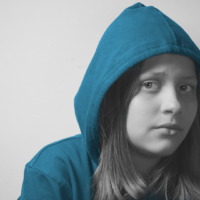Worldwide 10-20% of young people report having self-harmed at least once before the age of 18 and self-harm is one of the strongest risk factors for completed suicide. Added to this suicide is the 2nd leading cause of death for young people globally and therefore predictors such as self-harm are of great importance.
A critical topic that all those working in the field of child and adolescent mental health should know about. Learn about the latest research, the different types of interventions, and the evidence base that supports this. The Emanuel Miller Memorial Lecture & International Online Conference will focus on ‘Suicide and self-harm; The Research, The Evidence, The Interventions’ gathering together the leading academics, clinicians, and researchers in field.
About the talks
Confirmed speakers
About the talks – more details to follow
Dr. Michele Berk – ‘Dialectical Behavior Therapy with Adolescents with High Suicide Risk: Review of Recent Findings on Treatment Outcomes and New Directions’
This talk will review the data supporting the effectiveness of Dialectical Behavior Therapy (DBT) for reducing suicide-related outcomes in youth. In particular, the talk will focus on recent findings on trajectories of treatment response for suicidal ideation and self-harm and remission, recovery, relapse and recurrence rates for non-suicidal self-injury and suicide attempts. The clinical implications of these findings and future research priorities will also be reviewed.
Learning outcomes
- Understand the existing data on the effectiveness of DBT for reducing suicidal ideation and self-harm behaviors in adolescents.
- Understand the clinical implications of findings.
- Recognize the strengths and limitations of existing work and future directions for research on DBT for adolescent suicide prevention.
Professor Paul Plener – ‘What helps adolescents who self-harm? Therapeutic approaches for challenging behaviours’
Self-harming behaviours in adolescents are often challenging for clinicians to treat. The last 10 years have seen an increase in well-conducted studies on therapeutic approaches to target self-harming behaviours and a couple of meta-analyses have underlined the efficacy of psychotherapeutic interventions. This talk will provide an overview about existing psychotherapeutic interventions to address self-harming behaviours and will also provide an insight in new “non-psychotherapeutic” approaches that have been studied ,including psychopharmacological or other biologically oriented treatment methods.
Learning outcomes
- To understand different psychotherapeutic treatment approaches in self-harm in adolescents
- To be able to differentiate the evidence for different interventions for self-harm
- To gain knowledge about non talk-oriented therapeutic interventions for self-harm in adolescents
Professor Christian Schmahl – ‘Psychobiological mechanisms of non-suicidal self-injury’
Non-suicidal self-injury (NSSI) is a frequent dysfunctional behavior in adolescence and also part of the symptom spectrum of psychiatric conditions such as Borderline Personality Disorder (BPD). Most past research on NSSI has focused on epidemiology, risk factors, as well as functions of NSSI. Previous research on biological substrates of NSSI has been less extensive and has particularly focused on potentially underlying biological traits (cortisol, endogenous opioids, limbic brain regions, processing of painful stimuli) in individuals with NSSI. In spite of a high volatility of NSSI symptoms during adolescence, and effective treatment options, both resulting in substantial remission rates, however, it remains unclear why and how NSSI follows a more severe course in a substantial portion of individuals. It thus seems important to investigate state-related aspects of NNSSI and to dissect psychobiological processes involved in NSSI acts with different resolutions (i.e. at the biomolecular, endocrine, psychophysiological, neural, behavioural, and psychosocial level). Latest biological research in NSSI combines assessment during every-day life with experimental measures of mechanisms behind NSSI, including investigation of the autonomous nervous system and the HPA axis, pain sensitivity, endogenous opioids, inflammation, and resting prefrontal activity.
Learning outcomes
- To understand the importance of biological research in NSSI
- To understand the state-dependence of biological NSSI markers
- To recognise the importance of ambulatory assessment of psychobiological NSSI markers
Professor Dennis Ougrin and Dr. Tatum Cummins – ‘Pain sensitivity as a biomarker for self-harm in young people.’
Self-harm is a recognised risk factor for suicide in young people, however there are no established risk factors for self-harm. There is some evidence, mainly from studies on women with BPD, that people with self-harm show pain hyposensitivity. But little is known about the relationship between pain and non-pain sensitivity and self-harm in young people. We assessed somatosensory sensitivity in looked-after young people – a group at high-risk for self-harm and suicide – and young people living at home using a validated suite of quantitative sensory tests (QST). We completed testing on 64 young people (mean age 16.3 ± 1), 50 of which were recruited from local authority-run group homes and residential care settings in Glasgow and London. Associations between somatosensory sensitivity, incidence and frequency of self-harm within the previous year, residential status (looked-after vs. community-dwelling), age, gender, and antidepressant use were calculated. Young people with five or more incidences of self-harm in the previous year showed significant hyposensitivity to painful and non-painful QST measures compared to community-dwelling controls after adjusting for age, gender, and antidepressant use (both P<0.001). Pressure pain thresholds (PPT) accounted for most of the observed variance (AUC = 0.76, Sensitivity = 0.72, Specificity = 0.61). We concluded that sensory hyposensitivity is a phenotype of young people with self-harm and propose PPT to be a quick, cheap, and easy to interpret clinical test to identify youth at increased risk of repeat self-harm or suicide. We extended these findings to show that pain hyposensitivity is closely associated with history of sexual abuse.
Learning outcomes
- To understand risk factors for self-harm and suicide in young people
- To understand the complexities of pain perception
- To understand the differential impact of lived experience on pain sensitivity
- To appreciate the limitations of quantitative sensory testing measures
Professor Michael Kaess – ‘Nonsuicidal self-injury – a transdiagnostic marker of risk and psychopathology’
Nonsuicidal self-injury (NSSI) is a highly prevalent phenomenon among adolescents. During the past 10 years, research has begun to investigate NSSI as an own diagnostic entity following suggested diagnostic criteria in the DSM-5. However, there is now growing evidence that NSSI may serve best as a valid and strong transdiagnostic marker of psychopathology and risk.
The talk will present epidemiological, clinical and biological research that undermines the transdiagnostic character of NSSI. NSSI comes along with frequent and diverse comorbidity. There are well-replicated underlying mechanism such as impaired emotion regulation, stress vulnerability or frequent interpersonal problems that can be found in a variety of mental disorders. In addition, there is a strong association with diverse types of self-harm and risk-taking behaviors and NSSI is one of the strongest predictors of suicidal.
Finally, the talk will try to highlight the potential of NSSI as a marker of risk and its future role in detection and intervention of mental disorders.
Learning outcomes
- To understand the common underpinnings of NSSI
- To understand the role of NSSI as a transdiagnostic marker of psychopathology
- To understand the role of NSSI as a marker of suicide risk
Professor David Cottrell – ‘Reducing Self-harm in Adolescents: An Individual Participant Data meta-analysis (RISA-IPD). Pooled treatment effects, study and treatment moderators’
Self-harm is common in adolescents and a major public health concern. Evidence for effective interventions that stop repetition is lacking. We searched for RCTs published to January-2022. Eligible RCTs compared any therapeutic intervention against a control and aimed to reduce self-harm in adolescents (11-18) with past self-harm presenting to clinical services. Our primary outcome was repetition of self-harm at 12-months post-randomisation. Secondary outcomes included further repetition and time to self-harm, general psychopathology, depression, suicidal ideation, quality of life and death at 3, 6, 12, 18 and 24-months. Secondary analyses incorporated aggregate data (AD) from RCTs without IPD. We identified 39 eligible studies; 26 provided IPD (3448 participants), 7 provided AD (698 participants). We will present the key findings related to prevention repeat self-harm and impact on our secondary outcomes.
Learning outcome
- To understand more about Individual Participant Data meta-analyses
Dr. David Brent – Do We Need to Predict in Order to Prevent? The Challenge of Adolescent Suicide
Adolescent suicide rates in the United States has increased dramatically over the last 15 years, with similar trends in depression, suicidal ideation and attempts, and behavior. Suicide rates and attempts have risen sharply in adolescent girls (aged 10-14 yrs), and young adolescents of color. We explore the following: (1) the importance of screening in primary practice and ED settings; (2) alternative methods to identify suicidal behavior; and (3) the strengths and limitations of these alternative methods.
Method: Relevant literature was searched for reviews and meta-analyses related to the noted topics, using Google Scholar and PubMed. These articles were reviewed and summarized.
Results: There is evidence from cross-sectional and longitudinal studies, and experimental manipulation to support effective alternatives to self-reporting to identify suicidal behaviors. We discuss some of these alternatives, such as the Implicit Association Test, the application of machine learning to electronic health records, and the importance of mobile sensing and analysis of social media data.
Conclusions: Screening for suicidal behavior in clinical settings is of vital importance, however, additional methods, such as machine learning and mobile sensing can help identify adolescents at risk for suicide. Assessment of electronic health records, in addition to self-reports, provides more accurate information regarding suicidal behavior, and may help to identify temporal inflections.
Learning outcome
- You will learn about the rationale and importance of screening for suicide in adolescents
- You will learn of the strengths and limitations of self-reports for suicidal risk in adolescents
- You will learn about alternative methods for identifying and predicting suicidal risk in adolescents
Programme
Thursday 30 March
13:15 Professor Samuele Cortese – Welcome from ACAMH Academic Secretary
13:20 Professor Christian Schmahl – Psychobiological mechanisms of non-suicidal self-injury
14:05 Dr. David Brent – Do We Need to Predict in Order to Prevent? The Challenge of Adolescent Suicide
14:50 Break
15:05 Professor Dennis Ougrin and Tatum Cummins – Pain sensitivity as a biomarker for self-harm in young people
15:50 Dr. Michele Berk – Dialectical Behavior Therapy with Adolescents with High Suicide Risk: Review of Recent Findings on Treatment Outcomes and New Directions
16:35 Professor Samuele Cortese – Closing comments from ACAMH Academic Secretary
Friday 31 March
13:15 Professor Dennis Ougrin – Welcome from ACAMH Board Member
13:20 Professor Michael Kaess – Nonsuicidal self-injury – a transdiagnostic marker of risk and psychopathology
14:05 Professor David Cottrell – Reducing Self-harm in Adolescents: An Individual Participant Data meta-analysis
14:50 Break
15:05 Professor Paul Plener What helps adolescents who self-harm? Therapeutic approaches for challenging behaviors
15:50 Professor Dennis Ougrin – Closing comments from ACAMH Board Member
Confirmed speakers

Dr. Michele Berk is an Assistant Professor of Psychiatry and Behavioral Sciences at Stanford University. She is an expert on the treatment of suicidal adolescents. She was one of the Principal Investigators of an NIMH-funded, a multi-site, clinical trial of Dialectical Behavior Therapy (DBT) for adolescents. She has also studied the implementation of DBT with underserved, ethnic minority youth and families and DBT parenting interventions for parents of youth at high suicide risk. She currently testing a DBT intervention to support parents during the high risk transition between inpatient and outpatient treatment, funded by the American Foundation for Suicide Prevention.

Professor Christian Schmahl, Medical Director, Dept. of Psychosomatic Medicine and Psychotherapy, Central Institute of Mental Health, Mannheim, Germany. Christian’s research focus is on emotion regulation, self-injurious behaviour and dissociation as well as the interaction of neurobiology and psychotherapy in Borderline Personality Disorder and Posttraumatic Stress Disorder. He received his M.D. in Germany at Mainz and Giessen Medical School and did a residency in Psychiatry as well as in Psychosomatic Medicine. Since 2018 he is spokesperson of the Research Training Group “Impact of Adverse Childhood Experiences on Psychosocial and Somatic Conditions across the Lifespan”. He has published more than 250 articles and book chapters.

Professor Plener is Head of the Dept. of Child and Adolescent Psychiatry at Vienna General Hospital and Chair of Child and Adolescent Psychiatry at the Medical University of Vienna. He is president elect of the Austrian Association of Child and Adolescent Psychiatry. Professor Plener’s research interest is focused on Non suicidal Self-Injury, suicidality and trauma.

Dr. Tatum Cummins
Tatum currently works as the Editor for the journals BMC Neuroscience and BMC Neurology at Springer Nature. Tatum completed her PhD in Neuroscience at King’s College London under the supervision of the late Prof. Stephen B. McMahon, where she studied pain mechanisms in humans using psychophysics. In collaboration with Prof. Dennis Ougrin and Prof. Helen Minnis, they completed a study on somatosensory sensitivity in looked-after young people with and without self-harm using quantitative sensory testing measures.

Professor Ougrin, Consultant Child & Adolescent Psychiatrist, Reader in Child and Adolescent Psychiatry and Global Mental Health. Dennis graduated from a medical school in Ukraine in 1998 and came to the Maudsley hospital in the UK to undertake his post-graduate training in child and adolescent psychiatry. He worked as a consultant child and adolescent psychiatrist establishing and leading intensive community care services at South London and Maudsley NHS Foundation Trust. He also led the MSc in Child and Adolescent Mental Health at King’s College London and acted as the Chief Investigator of major NIHR, MRC and charity-funded studies in the field of self-harm and intensive community care services. In 2018-2020 Professor Ougrin was the editor-in-chief of Child and Adolescent Mental Health, a key clinical journal in child and adolescent psychiatry, psychology and allied disciplines. In September 2021 Professor Ougrin was appointed to lead the Youth Resilience Research Unit at Queen Mary University of London.
Professor Ougrin leads a programme of global mental health studies aimed at developing community mental health services in Ukraine and other Low- and Middle-Income Countries. His main professional interests include the prevention of Borderline Personality Disorder and effective interventions for self-harm in young people. He the author of Therapeutic Assessment, a novel model of assessment for young people with self-harm. He also developed and tested an Intensive Community Care Service model for young people with severe psychiatric disorders called Supported Discharge Service. The model was evaluated in the first randomised controlled trial of an intensive community care service for young people in the UK. The results of the trial informed the development of intensive community care services in the UK and internationally. Professor Ougrin has expertise in conducting randomised controlled trials in the fields of psychological therapy and mental health service models. He also works on developing modular psychotherapeutic interventions for self-harm and on understanding the pathophysiology of self-harm in young people.

Professor Michael Kaess
Michael Kaess is Professor of Child and Adolescent Psychiatry and Psychotherapy at the University of Bern as well as the Director of the University Hospital of Child and Adolescent Psychiatry and Psychotherapy Bern in Switzerland. In addition, Michael Kaess is heading a research section at the Center for Psychosocial Medicine at the University Heidelberg, Germany. Michael Kaess is an internationally renowned researcher in the field of adolescent risk-taking and self-harm behavior as well as early detection and intervention of potentially underlying mental disorders such as borderline personality disorders and affective disorders.

Professor David Cottrell
David was appointed Foundation Chair in Child & Adolescent Psychiatry at Leeds in 1994. He was Associate Medical Director for Child and Adolescent Psychiatry in Leeds for many years and has a wide experience of the development, management, delivery and evaluation of child and adolescent mental health services. His research interests are in the evaluation of psychological interventions and of Child and Adolescent Mental Health services. He was a co-author of the NICE guidelines on the management of depression in children and young people. He has been Chief Investigator of a large multi-centre randomised controlled trial investigating systemic family therapy following teenage self-harm (SHIFT, funded by NIHR), and co-investigator on a second multi-centre randomised controlled trial evaluating multi-systemic treatment for teenagers at risk of care or custody (START, funded by the Department of Health). His current research interests continue to focus on self-harm in young people. (Bio and image from the University of Leeds)

Dr. David Brent
Dr. Brent co-founded and now directs Services for Teens at Risk (STAR), a Commonwealth of Pennsylvania-funded program for suicide prevention, education of professionals, and the treatment of at-risk youth and their families. His work in the area of suicide has focused on the epidemiology of adolescent suicide, and has helped to identify the role of firearms, substance abuse, and affective disorders as risk factors for youth suicide.
Consequently, he and colleagues at UPMC Western Psychiatric Hospital have helped to establish the role of cognitive therapy as a treatment for depressed adolescents in an NIMH-funded clinical trial. Dr. Brent has also focused on the familial and genetic aspects of suicide; having found that suicidal behaviour clusters in families and is currently, along with colleagues at New York State Psychiatric Institute, studying how suicidal behaviour may be transmitted from parent to child.
Dr. Brent’s work has been funded by the William T. Grant Foundation and the National Institute of Mental Health, and he currently directs an NIMH-funded Advanced Center for Interventions and Services Research for Early-Onset Mood and Anxiety Disorders devoted to improving the life course of youth with mood and anxiety disorders, and consequently at high risk for suicide.

